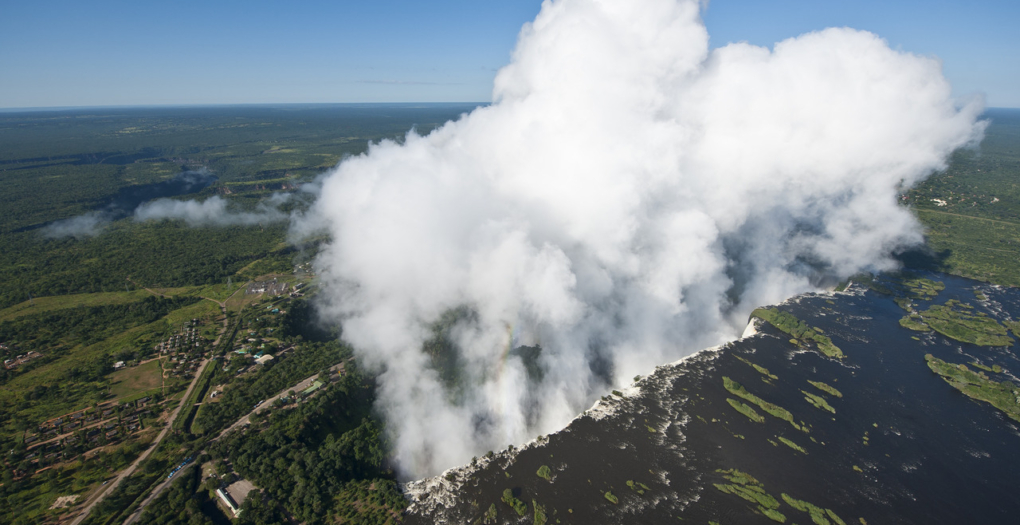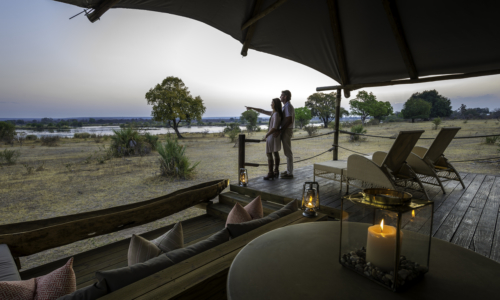Named in honor of Queen Victoria by the renowned Scottish missionary and explorer, David Livingstone, world-famous Victoria Falls is located on the mighty Zambezi River between the southern African countries of Zambia and Zimbabwe. While Victoria Falls is neither the tallest nor widest waterfall in the world, it is the largest in combined width of over 5,600 feet and height of over 350 feet, which together creates the largest sheet of falling water in the world. In comparison, North America’s Niagara Falls is barely 4,000 feet wide and just 170 feet high. Tourism to the Falls really began in 1905 when a rail line to Bulawayo was built.
A UNESCO World Heritage Site, Victoria Falls feeds a rainforest ecosystem adjacent to the falls. Uniquely, the Zambezi River leading up to the falls is not bounded by cliffs nor does it flow through a vast gorge. Instead, the river flows across a level plateau in a broad shallow valley until plunging into the deep Victoria Falls chasms. Below the falls, the Zambezi continues its descent through various falls, gorges, and rapids over the next 150 miles.
Victoria Falls changes at different times of the year. Peak flood season is around March and April when the full power of the Falls can be experienced in all its glory. Because of the masses of spray rising from the fallen water, the full width of the Falls can’t be seen on foot. However, an aerial view at this time is spectacular, with clouds of spray rising high into the sky. As the floods subside the view of the Falls gets better throughout the year. At its lowest, around November and December, the Falls become little rivulets running over the edge and in some places there is no water falling at all.
Today, Victoria Falls hosts over a quarter of a million tourists each year. Commissioned in 1900, the Victoria Falls bridge provides a spectacular perspective. Tours of the Falls are available from either the Zambian or Zimbabwean side. One stunning vantage point is across the Knife-edge Bridge, where visitors can have the finest view of the Eastern Cataract and the Main Falls. Adrenaline junkies will enjoy bungee jumping, white water rafting, river surfing, zip lines, kayaking, and gorge swings. More sedate activities include river cruises and sundowners on the Zambezi River where visitors can see plenty of hippos and Nile crocodiles.


- Baines’ River Camp
- Bilimungwe Bushcamp
- Busanga Bush Camp
- Chamilandu Bushcamp
- Chiawa Camp
- Chindeni Bushcamp
- Chinzombo
- Chongwe Camp
- Kaingo Camp
- Kakuli Camp
- Kapamba Bushcamp
- King Lewanika
- KuKaya
- Kuyenda Bushcamp
- Lion Camp
- Lolebezi Safari Lodge
- Luangwa River Camp
- Luwi Camp
- Mchenja Camp
- Mfuwe Lodge
- Mwamba Camp
- Nkwali
- Nsefu Camp
- Nsolo Camp
- Old Mondoro
- Potato Bush Camp
- Puku Ridge Camp
- Royal Zambezi Lodge
- Sausage Tree Camp
- Shumba Camp
- Sindabezi Island
- Sungani Lodge
- Sussi & Chuma
- Tena Tena Lodge
- The River Club
- Thorntree River Lodge
- Tintswalo at Siankaba
- Toka Leya Camp
- Tongabezi
- Zungulila Bushcamp
Coming soon!
- Baines’ River Camp
- Bilimungwe Bushcamp
- Busanga Bush Camp
- Chamilandu Bushcamp
- Chiawa Camp
- Chindeni Bushcamp
- Chinzombo
- Chongwe Camp
- Kaingo Camp
- Kakuli Camp
- Kapamba Bushcamp
- King Lewanika
- KuKaya
- Kuyenda Bushcamp
- Lion Camp
- Lolebezi Safari Lodge
- Luangwa River Camp
- Luwi Camp
- Mchenja Camp
- Mfuwe Lodge
- Mwamba Camp
- Nkwali
- Nsefu Camp
- Nsolo Camp
- Old Mondoro
- Potato Bush Camp
- Puku Ridge Camp
- Royal Zambezi Lodge
- Sausage Tree Camp
- Shumba Camp
- Sindabezi Island
- Sungani Lodge
- Sussi & Chuma
- Tena Tena Lodge
- The River Club
- Thorntree River Lodge
- Tintswalo at Siankaba
- Toka Leya Camp
- Tongabezi
- Zungulila Bushcamp
Coming soon!

Named in honor of Queen Victoria by the renowned Scottish missionary and explorer, David Livingstone, world-famous Victoria Falls is located on the mighty Zambezi River between the southern African countries of Zambia and Zimbabwe. While Victoria Falls is neither the tallest nor widest waterfall in the world, it is the largest in combined width of over 5,600 feet and height of over 350 feet, which together creates the largest sheet of falling water in the world. In comparison, North America’s Niagara Falls is barely 4,000 feet wide and just 170 feet high. Tourism to the Falls really began in 1905 when a rail line to Bulawayo was built.
A UNESCO World Heritage Site, Victoria Falls feeds a rainforest ecosystem adjacent to the falls. Uniquely, the Zambezi River leading up to the falls is not bounded by cliffs nor does it flow through a vast gorge. Instead, the river flows across a level plateau in a broad shallow valley until plunging into the deep Victoria Falls chasms. Below the falls, the Zambezi continues its descent through various falls, gorges, and rapids over the next 150 miles.
Victoria Falls changes at different times of the year. Peak flood season is around March and April when the full power of the Falls can be experienced in all its glory. Because of the masses of spray rising from the fallen water, the full width of the Falls can’t be seen on foot. However, an aerial view at this time is spectacular, with clouds of spray rising high into the sky. As the floods subside the view of the Falls gets better throughout the year. At its lowest, around November and December, the Falls become little rivulets running over the edge and in some places there is no water falling at all.
Today, Victoria Falls hosts over a quarter of a million tourists each year. Commissioned in 1900, the Victoria Falls bridge provides a spectacular perspective. Tours of the Falls are available from either the Zambian or Zimbabwean side. One stunning vantage point is across the Knife-edge Bridge, where visitors can have the finest view of the Eastern Cataract and the Main Falls. Adrenaline junkies will enjoy bungee jumping, white water rafting, river surfing, zip lines, kayaking, and gorge swings. More sedate activities include river cruises and sundowners on the Zambezi River where visitors can see plenty of hippos and Nile crocodiles.

- Baines’ River Camp
- Bilimungwe Bushcamp
- Busanga Bush Camp
- Chamilandu Bushcamp
- Chiawa Camp
- Chindeni Bushcamp
- Chinzombo
- Chongwe Camp
- Kaingo Camp
- Kakuli Camp
- Kapamba Bushcamp
- King Lewanika
- KuKaya
- Kuyenda Bushcamp
- Lion Camp
- Lolebezi Safari Lodge
- Luangwa River Camp
- Luwi Camp
- Mchenja Camp
- Mfuwe Lodge
- Mwamba Camp
- Nkwali
- Nsefu Camp
- Nsolo Camp
- Old Mondoro
- Potato Bush Camp
- Puku Ridge Camp
- Royal Zambezi Lodge
- Sausage Tree Camp
- Shumba Camp
- Sindabezi Island
- Sungani Lodge
- Sussi & Chuma
- Tena Tena Lodge
- The River Club
- Thorntree River Lodge
- Tintswalo at Siankaba
- Toka Leya Camp
- Tongabezi
- Zungulila Bushcamp
Coming soon!
- Baines’ River Camp
- Bilimungwe Bushcamp
- Busanga Bush Camp
- Chamilandu Bushcamp
- Chiawa Camp
- Chindeni Bushcamp
- Chinzombo
- Chongwe Camp
- Kaingo Camp
- Kakuli Camp
- Kapamba Bushcamp
- King Lewanika
- KuKaya
- Kuyenda Bushcamp
- Lion Camp
- Lolebezi Safari Lodge
- Luangwa River Camp
- Luwi Camp
- Mchenja Camp
- Mfuwe Lodge
- Mwamba Camp
- Nkwali
- Nsefu Camp
- Nsolo Camp
- Old Mondoro
- Potato Bush Camp
- Puku Ridge Camp
- Royal Zambezi Lodge
- Sausage Tree Camp
- Shumba Camp
- Sindabezi Island
- Sungani Lodge
- Sussi & Chuma
- Tena Tena Lodge
- The River Club
- Thorntree River Lodge
- Tintswalo at Siankaba
- Toka Leya Camp
- Tongabezi
- Zungulila Bushcamp
Coming soon!










































